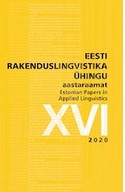MITMEVIISILINE SUHTLUS JA TEISTE KÄITUMISE MÕISTMINE SÕJAVÄELISTEL JUHTIDEL
MULTIMODAL COMMUNICATION AND UNDERSTANDING OF THE BEHAVIOR OF OTHERS AMONG MILITARY LEADERS
Author(s): Silvi TenjesSubject(s): Military policy, Political behavior, Theory of Communication, Cognitive Psychology, Behaviorism
Published by: Eesti Rakenduslingvistika Ühing (ERÜ)
Keywords: multimodal communication; referencing; embodied simulation; intersubjectivity; military leaders; Estonian;
Summary/Abstract: This article analyses multimodal communication in the context of the defense forces. The research focuses on the specific nature of interactions in the military that require the practice of routine activities to be applied in unexpected situations. This unique context affects aspects of interactive communication. The data were collected as part of a research project on multimodal communication among military leaders. The relationship between the research question and more recent theoretical approaches to intersubjectivity is related to the results of brain research that gives insights into the mechanisms of imitation and simulation. They form the basis for brain-body system models in interaction with the world. Underlying embodied simulation is discussed in regard to the concept of intersubjectivity as a shared meaning space (Gallese 2003). The ability to model interactions between the environment and the organism within it allows our brains to model the behavior of others in much the same way as it models our own behavior. Imitation and simulation abilities help to understand and predict the behavior of others. This knowledge is already being applied to improve team effectiveness through shared mental models in 21st century military operations. The results of qualitative analysis extend our understanding of referencing and the behavior of modalities in communication. The paper provides insights how one modality could refer to another one. The interactive nature of the military revealed the use of artifacts that the civilian world does not consider to be commonplace. In military situations, it is of utmost importance to interpret the behavior of others in the most correct way in terms of meaning. The use of simulation routines in learning situations is one means to achieve that. Activity tracking is expected to trigger automatic simulation of action, and, in real-world situations, registered routines will enable military leaders to behave appropriately and make the right decisions in a swift manner.
Journal: Eesti Rakenduslingvistika Ühingu aastaraamat
- Issue Year: 2020
- Issue No: 16
- Page Range: 203-221
- Page Count: 19
- Language: Estonian

